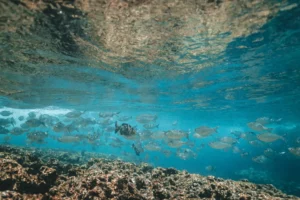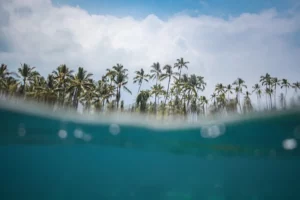As global temperatures rise, marine ecosystems are undergoing significant transformations, a process commonly referred to as tropicalization. This phenomenon entails the migration of tropical herbivores towards subtropical regions, driven by the search for suitable habitats and food sources amidst changing environmental conditions. As tropical herbivores, including species such as sea turtles and manatees, expand their ranges poleward, they bring with them unique ecological roles and behaviors that can disrupt the delicate balance of subtropical marine ecosystems. The repercussions of tropicalization extend far beyond mere shifts in species distributions; they encompass a myriad of ecological interactions and processes that shape the functioning and resilience of these ecosystems.
One of the key ecosystems impacted by tropicalization is subtropical seagrass meadows, which serve as vital habitats and nurseries for numerous marine species. Seagrasses play a crucial role in coastal ecosystems, providing food and shelter for fish and other marine organisms, stabilizing sediments, and cycling nutrients. However, the influx of tropical herbivores into subtropical waters poses a significant threat to the integrity of seagrass meadows. These herbivores, adapted to warmer waters, may exhibit different feeding behaviors and preferences compared to their subtropical counterparts, leading to increased grazing pressure on seagrass beds.
Risks to Subtropical Seagrass Meadows
A recent study published in Nature Ecology & Evolution delves into the potential risks posed by the influx of tropical herbivores to subtropical seagrass meadows. Led by a team of researchers from esteemed institutions such as the University of South Florida and Florida International University, the study underscores the vulnerability of these critical habitats to the encroachment of herbivores adapted to warmer waters. By examining the responses of subtropical seagrasses, including the iconic turtlegrass, to simulated grazing across different latitudes, the researchers shed light on the intricate ecological dynamics at play.
Seagrass meadows are integral components of coastal ecosystems, providing essential ecosystem services such as carbon sequestration, nutrient cycling, and habitat provision. However, they face increasing threats from human activities and environmental stressors, including coastal development, pollution, and climate change. The introduction of tropical herbivores into subtropical seagrass habitats adds another layer of complexity to these challenges, potentially exacerbating the degradation of these critical ecosystems.
Understanding the Impact
Through a series of meticulously designed experiments conducted in seagrass beds spanning diverse latitudinal gradients, the researchers uncovered compelling evidence of the diminished resilience of subtropical seagrasses to heavy grazing pressure from tropical herbivores. This reduced productivity in response to simulated grazing highlights the potential challenges faced by subtropical seagrass meadows in sustaining their ecological functions amidst the changing marine landscape. By elucidating the nuanced responses of seagrass ecosystems to the burgeoning presence of tropical herbivores, the study offers valuable insights into the complex interplay between climate change and marine biodiversity.
Implications for Marine Ecosystems
The infiltration of tropical herbivores into subtropical waters portends significant implications for the long-term health and stability of seagrass ecosystems. Overgrazing by herbivores, compounded by existing stressors such as degraded water quality, poses a formidable threat to the integrity of subtropical seagrass meadows. The study underscores the urgent need for proactive conservation measures aimed at safeguarding these vital habitats and preserving the myriad ecological services they provide.

Seagrass meadows play a crucial role in supporting marine biodiversity, providing habitat for numerous species of fish, invertebrates, and other marine organisms. Additionally, they contribute to coastal protection by stabilizing sediments and attenuating wave energy, thereby reducing shoreline erosion and mitigating the impacts of storms. Moreover, seagrasses are highly efficient carbon sinks, sequestering substantial amounts of carbon dioxide from the atmosphere and helping to mitigate climate change.
To address the threats posed by the tropicalization of subtropical seagrass ecosystems, collaborative efforts involving scientists, policymakers, conservationists, and local communities are essential. Conservation strategies may include the establishment of marine protected areas, implementation of sustainable fisheries management practices, reduction of nutrient pollution from agricultural runoff and urban development, and restoration of degraded seagrass habitats. By prioritizing the conservation of subtropical seagrass meadows and implementing effective management measures, stakeholders can enhance the resilience of these valuable ecosystems in the face of environmental change.
Protecting Subtropical Seagrass Meadows
Central to the conservation of subtropical seagrass meadows is the preservation of water quality, a foundational element of ecosystem health and resilience. By mitigating pollution and other anthropogenic stressors, policymakers and conservationists can enhance the capacity of seagrass ecosystems to withstand the challenges posed by climate change and the incursion of tropical herbivores.
Efforts to improve water quality may involve the implementation of regulations and best management practices aimed at reducing nutrient runoff from agricultural activities, sewage discharge, and coastal development. Additionally, initiatives to control sedimentation, chemical contaminants, and invasive species can help maintain favorable conditions for seagrass growth and reproduction. Collaborative partnerships between government agencies, non-profit organizations, research institutions, and local communities are essential for implementing effective water quality management strategies and monitoring programs.
Moreover, fostering greater awareness and understanding of the ecological significance of subtropical seagrass meadows is essential for garnering support and mobilizing collective action towards their protection. Education and outreach initiatives targeting policymakers, stakeholders, and the general public can help raise awareness about the importance of seagrass ecosystems in supporting biodiversity, fisheries, carbon sequestration, and coastal resilience. Public engagement activities such as citizen science projects, interpretive signage, and community-based restoration efforts can empower individuals to become stewards of seagrass habitats and advocate for their conservation.
By prioritizing water quality management and increasing public awareness of the ecological value of subtropical seagrass meadows, stakeholders can work together to safeguard these critical ecosystems for future generations.
Call to Action
As tropical herbivores continue to extend their ranges into subtropical waters, there is an urgent imperative to redouble efforts in conserving and restoring seagrass habitats. By embracing a holistic approach to marine conservation that integrates science, policy, and community engagement, we can forge a path towards a more sustainable future for subtropical seagrass ecosystems and the myriad species that depend on them. Now is the time for decisive action to safeguard these invaluable habitats and preserve the rich biodiversity they harbor for generations to come.
Related Topics :
- Move climate action forward faster together with 2024 Climate Ambition Accelerator – Micro2media
- Rapid tropicalization evidence of subtidal seaweed assemblages along a coastal transitional zone | Scientific Reports
- https://www.sciencedirect.com/science/article/pii/S0169534723002732
- Cultivating Abundance: Scaling Up Your Urban Farm for Success – Micro2media

